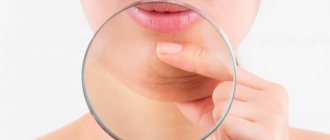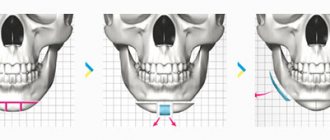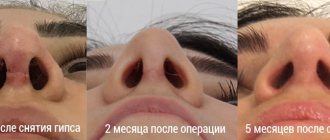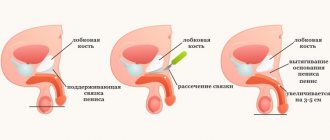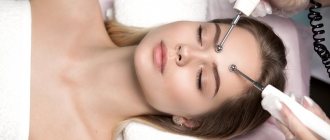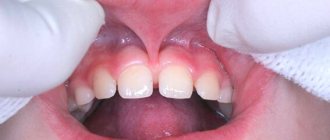Mentoplasty is a plastic surgery to eliminate defects of the chin associated with its shape and size.
With the help of mentoplasty, you can either reduce or enlarge the chin, changing its anatomical shape. There are several types of surgery, each of which has its own purpose and technical features.
Preparation for surgery:
During the preliminary examination, the plastic surgeon decides together with the patient what result they want and can (depending on the initial data) achieve. The doctor evaluates the condition of the jaw, bone density, degree of deformation, discusses the intervention technique, and gives recommendations on preparing for plastic surgery. In special cases, the doctor may request an additional X-ray of the jaw or an orthodontist’s report. If a person smokes, it is advisable to reduce the number of cigarettes per day if possible - for faster and easier rehabilitation.
Chin reduction or enlargement, as well as other corrections, are performed under general anesthesia and the patient will need to undergo a comprehensive preoperative examination, including blood, urine, and ECG tests.
Chin correction. (Before and After Photos)
The chin is the foundation, as is the cheekbone area. That is why close attention is paid to these areas when it comes to rejuvenating and refreshing the face.
If the chin is large or square, this creates the feeling of a heavy face, a large jaw, which undoubtedly suits men, but does not add femininity to the face at all. If the chin is too small, then age-related features on the face begin to appear very quickly, and in general the face looks disharmonious. Asymmetries do not always “spoil” the face; their presence begins to appear more with age, complementing the tired appearance.
Therefore, of course, a cosmetologist, like an artist or sculptor, evaluates the face as a whole, and if he sees a lack of harmony due to the characteristics of the chin, he tries to smooth them out. I would like to especially note that you should not make all faces the same cheekbones + lips + chin, but rather harmonize this particular face without distorting the features or crossing out the main thing.
Chin augmentation techniques:
If chin augmentation is necessary, several techniques can be used, depending on the tasks and the anatomy of the jaw.
Installation of an artificial implant:
Modern maxillofacial prostheses are made from elastic, but very strong, reliable and inert materials, so that the risk of an allergic reaction or rejection is minimized. Implants are available in different shapes and sizes, but they can be custom-made for a specific patient. The surgeon makes a small incision from the inside - from the mucous membrane, and forms a special pocket where the implant is tightly installed. The incision is sutured and no external traces of the operation remain. Similar to an implant, the patient’s own cartilage tissue can be used. It is usually taken from the costal or ear cartilage and is installed in the same way from the inside into the formed pocket.
Augmentation osteotomy of the mandible:
Chin correction can be performed using an osteotomy. In this case, a fragment of bone is cut off and moved anteriorly if the chin needs to be enlarged or repositioned from below when reduction is necessary. When an operation is performed on the patient's bone, the fragments are fixed with titanium plates, and the seam still remains invisible because it is located under the jaw.
Chin lipofilling:
In some cases, it is enough to visually enlarge the chin with lipofilling - using the patient’s own fat taken from the abdomen, thighs, buttocks or “double chin”, if any. A few injections and the face takes on the harmonious, desired shape. Also, lipofilling can be used to complement any type of correction, be it osteotomy or implant installation, if the surgeon considers it necessary to level out the resulting void or remove asymmetry.
Alternatives to mentoplasty
There are some alternatives to chin correction surgery that are less invasive and faster, but often not as effective:
- Fillers . For minimal changes, fillers such as Radiesse can be injected into the chin area to change its shape. However, they do not provide a long-term solution to the problem. Men often choose this method of chin surgery.
- Submental liposuction is a procedure that involves removing fatty tissue to make a major change to the chin. This procedure has a faster recovery period than chin correction surgery, but it is also invasive and may not produce significant results.
- Orthodontic surgery - This procedure makes changes to the patient's dental structure, which is expected to change the chin. However, this method is long and achieving a pronounced effect may take several years.
Chin reduction techniques:
Chin reduction surgery (genioplasty) is most often resorted to by women due to dissatisfaction with the shape of the lower jaw or the presence of a skin-fat fold.
Reducing osteotomy of the mandible:
Osteotomy is also performed to reduce the chin. The “extra” bone fragment is cut off, polished if necessary, brought to the desired shape and repositioned with a posterior displacement using titanium plates. After surgery, the stitches are placed under the jaw.
Double chin liposuction:
To correct a double chin, liposuction is performed on the lower side of the jaw using a vacuum or radiofrequency method. Only a few punctures remain, which then quickly heal, and if there was no significant amount of subcutaneous fat, the skin quickly restores its elasticity, begins to fit tightly to the jaw and the face takes on neat features.
Contraindications to mentoplasty
Mentoplasty is not performed on patients under 18 years of age. Also, the operation is not recommended for patients under 23–25 years of age, since at this age the bone skeleton continues to form, and for patients after 60 due to the difficult healing process. Absolute contraindications to surgery include:
- circulatory pathologies;
- epilepsy;
- decompensated diabetes mellitus;
- chronic diseases of blood vessels, heart, kidneys and liver;
- skin damage in the correction area;
- disorders of the thyroid gland;
- dental diseases;
- neuropsychiatric diseases.
How is the operation performed?
On the scheduled day, in the morning on an empty stomach, the patient enters the clinic, the surgeon performs preliminary markings in the ward, and they are sent to the operating room.
Depending on the technique used, the operation takes from 1 to 2.5 hours. Often, patients combine chin surgery with other facial interventions, which is convenient both from an economic point of view and in terms of recovery. After plastic surgery, the patient is put on a compression bandage and left for a day in the clinic under observation.
Remove double chin
A double chin is one of the most common complaints of people of any age. It can appear from birth, after weight gain and as a result of age-related changes. To make the chin and neck area attractive, we offer a special complex that will help remove excess skin and fat, tighten sagging skin, and make the cervical-chin angle clear. This result can be achieved by combining liposuction and platysmoplasty.
Recovery period:
Mentoplasty is a low-traumatic operation, but requires care in the postoperative period. During augmentation surgery, it is important to allow a pocket to form that will tightly hold the implant. Therefore, the pressure bandage must be worn for about three weeks. At this time you need to sleep on your back, limit facial movements, and do not go to the sauna. Within three days, the patient may experience pain, especially when chewing, notice hematomas and swelling, which will then go away on their own. If stitches are applied, they are usually removed within 7-10 days. If access was made through the oral mucosa, you need to follow a diet - do not eat hot, very cold, spicy, and in any case avoid solid foods.
Types
There are two main types of genioplasty:
Sliding genioplasty
During a sliding genioplasty, I use a saw to separate the chin bone from the rest of the jaw.
Next, I move the chin, moving it forward or backward to correct the position of the chin.
I can also correct chin asymmetry by moving or altering one side of the chin to match the other.
After repositioning the chin bone, I secure it to the jaw with special staples and surgical screws.
Chin augmentation with an implant
I can also reshape, lengthen or enlarge the chin by attaching plastic or silicone implants to the existing chin bone.
During this procedure, I place the implant over the chin bone, securing it with sutures or screws.
Filler injections are a temporary, non-surgical alternative to chin implant placement.
This type of chin augmentation involves injections of fillers to improve the shape of the chin and the overall appearance of the face.
Fillers can be fat, calcium hydroxylapatite or polycaprolactone.
Operation description
Neck lift surgery is usually performed under intravenous anesthesia. The scope of the operation and the specifics of the technique depend on the elasticity of the skin, weight, age of the patient and the nature of changes in the neck area. If the patient is overweight, platysmoplasty can be combined with liposuction of the neck and chin. If the skin is severely stretched (for example, after significant weight loss or with serious age-related changes), the surgeon can remove its excess.
An incision is made in the submental fold; if necessary, additional small incisions are made behind the ears. The doctor places the incisions in natural folds, which improves the cosmetic qualities of the scar and additionally disguises it. As a result, a thin cosmetic seam looks like a fold of skin. The next stage is strengthening the platism. To do this, the separated edges of the muscle are sutured along the midline. If necessary, additional wedge-shaped excision of the inner edge of the platysma helps to better emphasize the contour of the angle between the neck and chin. If there is pronounced subplatysmal fat, its resection (removal) is also performed.
Then the wound is stitched layer by layer while maintaining uniform tension of the muscle, and a cosmetic suture is applied to the skin at the site of the incisions. To consolidate the effect and reduce postoperative swelling, a pressure modeling bandage is applied to the neck and chin area, which must be worn for several days.
Risks and complications
Sliding genioplasty (mentoplasty) procedures and chin augmentation with implants are safe and effective methods for improving the appearance of the chin.
However, all surgical procedures carry a risk of side effects and complications.
Genioplasty procedures may result in temporary side effects such as:
- redness or bruising
- hypersensitivity or pain
- swelling
- decreased sensation or numbness
Possible complications of genioplasty include:
- infection
- damage to nerves or tooth roots
- allergic reaction to filler or implant material
- changes in implant position
Rehabilitation
Several factors influence recovery time after chin surgery, such as:
- type of transaction
- degree of surgical changes
- speed of regenerative processes
- presence of any complications such as infection
After the chin augmentation procedure with an implant, the patient can return to work after 7 days.
The chin may appear completely normal after a few weeks. However, complete recovery occurs when there is no longer evidence of residual swelling, which may take 3 months.
Patients who have had sliding genioplasty or chin implant surgery should see their surgeon regularly to monitor healing and address any complications.
Fillers do not leave scars and have a shorter recovery time than sliding genioplasty and chin implant surgeries.


